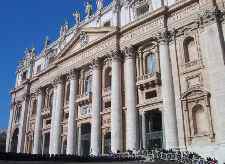
(55K)
591 x 432
| Sunday: St. Peters (again) - The facade by Maderno, done in travertine marble, reads: "In honor of the Prince of the Apostles, Pope Paul V Borghese, a Roman, in the year 1612, the 7th of his pontificate."
|
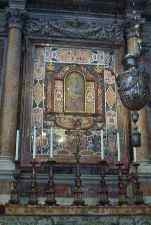
(38K)
437 x 648
| Mater Ecclesiae - Mother of the Church, the altar where I had Mass this morning. |
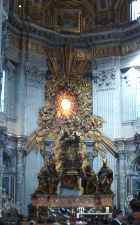
(37K)
425 x 681
| Bernini's spectacular bronze chair, which encases the Chair of Peter, below the golden alabaster window of a dove, representing the Holy Spirit.
|
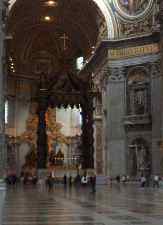
(31K)
472 x 648
| With over 225,000 square feet of floor area, a picture hardly captures the awesome size. |
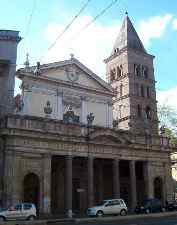
(33K)
455 x 576
| Monday: St. Chrysogonus, a Roman military officer named in the Roman Canon, who was imprisoned and then later beheaded by Diocletian around the year 304. The belltower was built in 1124.
|
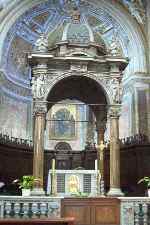
(43K)
434 x 648
| A church on this site dates back to the 5th century, over what was possibly the Roman house of Chrysogonus. Under the altar is the relics of St. Chrysogonus and the arm of St. James (the Great). |

(37K)
324 x 720
| In the 12th century, the present church was built over the original.
|

(35K)
648 x 434
| In 1907 this original, lower church was discovered under the current one, 20 feet below street level. |
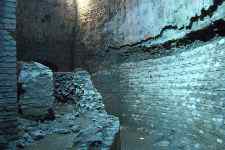
(40K)
648 x 434
| Here is the apse from the old church, where the remains of the martyr's shrine and traces of early frescos can still be seen.
|
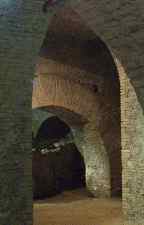
(27K)
432 x 674
| Continuing through the subterranean church of the 5th century. |
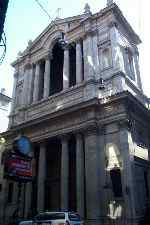
(37K)
434 x 648
| Tuesday: Santa Maria in Via Lata, also dating from the 5th century, was rebuilt in the 11th and 15th centuries to take the form we see today.
|
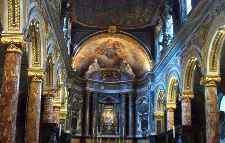
(50K)
720 x 458
| According to strong tradition, St. Paul is said to have spent 2 years of his imprisonment here under house arrest. Thus an underground oratory contains paintings depicting the imprisonment of St. Paul. |
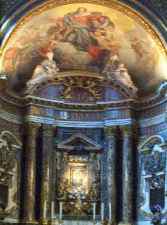
(36K)
432 x 582
| Above the altar is a 13th century icon of the the Vergine Avvocata, Mary as our Advocate, said to have caused many miracles.
|
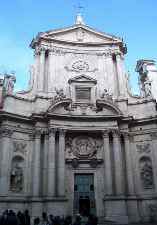
(37K)
454 x 648
| Wednesday: St. Marcellus, Pope from 308-309, opened an oratory in the house of a devout lady. The oratory was expanded in the 5th century, and his relics were brought here in the 9th century and interred beneath the high altar. |
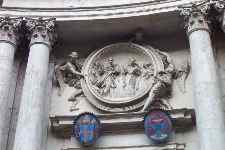
(36K)
648 x 434
| The old church burned down in 1519, and so was completely rebuilt (facing the opposite direction!)
|
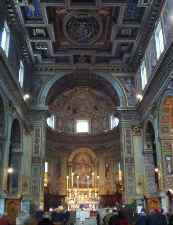
(32K)
445 x 576
| A wooden crucifix (not pictured) survived the disastrous fire, and so is still venerated as miraculous (it was carried thought the streets in anticipation of Vatican II). |

(33K)
416 x 648
| Thursday: St. Appolinare was the first Bishop of Ravenna, said to be a disciple of St. Peter. Three times he was exiled from the city, but his great work made many converts. He was attacked by a mop and died as a martyr during the time of Emperor Vespian (69-79 AD).
|
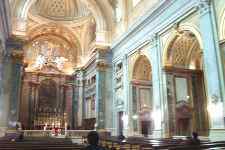
(36K)
648 x 434
| Originally, this early church was constructed on the ruins of the Neronian-Alexandrian baths. It was restored in the 8th century and completely rebuilt in the 19th. |

(42K)
439 x 720
| In the 16th century, the church was given to St. Ignatius of Loyola, for the college he had recently founded. Therefore it has pictures of many Jesuits saints.
|

(32K)
429 x 648
| For example, this is a statue of St. Francis Xavier. Why is he pictured with a crab? The story is that as he was arrived at India, he dropped his cross which fell into the ocean. But later on the beach a crab crawled up carrying his cross. |
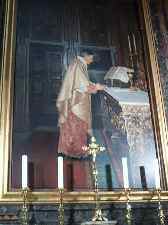
(35K)
484 x 648
| Today the church is part of Santa Croce university, run by Opus Dei, so this side altar is of their own recent saint, St. Jose Maria Escriva, pictured saying mass.
|
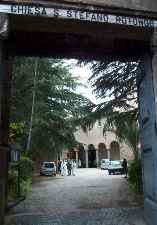
(38K)
454 x 648
| Friday: Santo Stefano Rotondo, as the sign above the gate tells us, this church was build on a site that was sacred to the ancient Romans, including a large army barracks with a pagan sanctuary to Mithras. |
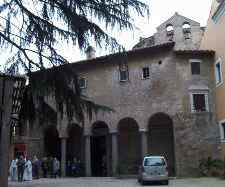
(37K)
576 x 479
| Today the site is sacred to christians who venerate it as a place to give glory to saints and martyrs. (Notice the procession as they chant the litany of saints.)
|
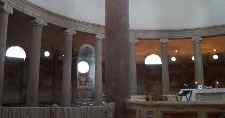
(21K)
720 x 380
| The 5th century church originally held the relics of St. Stephen, the first martyr in Jerusalem, whose relics were discovered in 415. Later it was rededicated to St. Stefan, King of Hungary. |
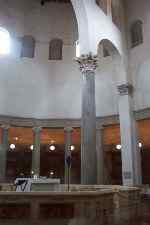
(20K)
434 x 648
| Because of its connection with the Holy Land, it was modeled on the Church of the Holy Sepulcher, making it one of the oldest of round churches in Rome with a central altar.
|
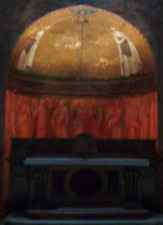
(16K)
432 x 595
| This is a side chapel to Sts. Primus and Felician, whose relics were brought here in the 7th century. Although hard to see here, their martyrdom and burial is portrayed in a rare 7th century mosaic. |
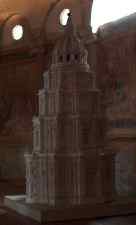
(16K)
392 x 648
| I don't know what this is, but it looked interesting - probably the spire from a dome / steeple.
|
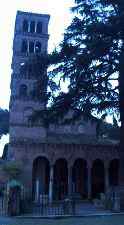
(31K)
358 x 648
| Saturday: St. Giovanni a Porta Latina, dedicated to St. John the Apostle, based on the tradition that he spend some time in Rome before being banished to the Island of Patmos. Notice the beautiful location and superb 12th century belltower. |
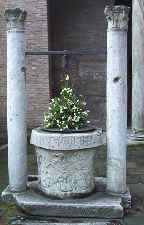
(36K)
432 x 673
| This ancient well in the forecourt is interesting as the words of baptism are carved in its lip. The pillars are holding up nothing but air (part of a medieval portico).
|
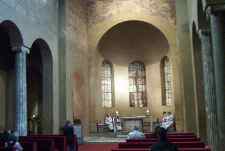
(24K)
641 x 432
| A very simple interior, with beautiful antique columns lining the isles. The church was reconstructed in the 12th century, with many remodelings since then. |

(22K)
417 x 648
| In one of the remodelings, the 12th century frescos were painted over. An interesting cycle of biblical scenes from the Old and new Testament, they were restored in 1940.
|

(48K)
422 x 648
| Since St. John had greatly upset the pagan worship by his work in Ephesus, it is said they attempted to have him boiled in oil, but when he came out it was as if he had taken a refreshing bath. (This stained glass window is in the Sacristy.) |
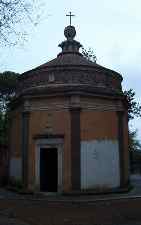
(24K)
408 x 648
| At the time of St. John the Apostle (around 90 AD), this was outside the city of Rome (a very swampy area). But since John had angered the Ephesian's god, they wanted to kill him in this spot because there was a shrine to that god here.
|
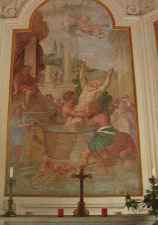
(26K)
432 x 615
| This painting recalls the scene. It is inside the small octagonal chapel (built in 1509) which marks the spot where St. John was "boiled". |
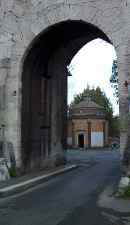
(29K)
418 x 720
| In the 3rd century, the Roman's built this wall around the city, and so here the little chapel of St. John in Oil can been seen through the Porta Latina (Latin Gate).
|
|
|


































